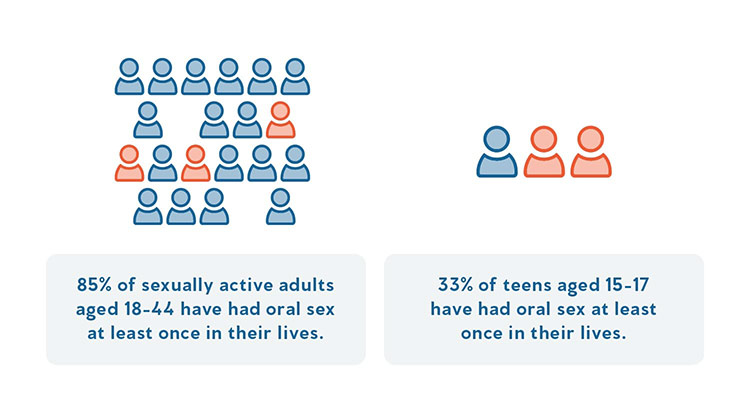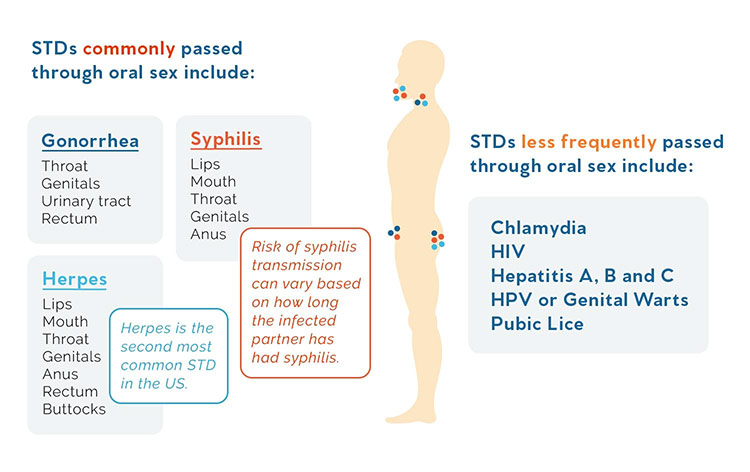While oral sex greatly reduces the risk of pregnancy for partners that can get pregnant, you still stand the risk of getting an STD from oral sex. There are a few different STDs you can contract through oral sex and a few different ways you can contract them.
Oral sex, by definition, is any act that involves oral (use of the lips, mouth or tongue) stimulation of a partner’s genitals, genital area and/or anus. Oral sex is a common sexual practice, with more than 85% of sexually active adults ages 18-44 reporting to have had oral sex at least once in their lives, according to a national survey conducted by the CDC. Oral sex is especially common with sexually active young adults, with another survey revealing that 33% of teens aged 15-17 reported having had oral sex before.
There are many factors that contribute to the rates of STD transmission from oral sex, but a large factor is that different people can define “having sex” as different sexual acts. Many people don’t consider oral sex to be “real” sex, but the reality is that oral sex is a sexual act like any other. These differing definitions can lead to some confusion, especially among young people, about whether or not they could have an STD if they’ve only given or received oral sex. Especially with a new partner, it’s important to make the distinction that oral sex is sex, and that even if they haven’t had penetrative sex before, or since their last partner, or since they were last tested, they could still have an STD.
In general, common forms of STD transmission through oral sex include contracting an STD from the mouth or throat from giving oral sex to a partner with a genital or anal/rectal infection. Similarly, it’s possible to contract a genital or anal/rectal infection by having a partner with a mouth or throat infection perform oral sex on you. It’s also possible to have an STD infection in more than one area at a time, such as the mouth and genitals, so oral sex and related sexual acts can increase your risk of having an infection in one area spread to a different area.
STDs commonly passed through oral sex include:
Gonorrhea
Common sites of gonorrhea infection include the throat, genitals, urinary tract and rectum. Gonorrhea transmission can occur when giving oral sex to a partner with an infected genital area, urinary tract or rectum, possibly resulting in an infection of gonorrhea in the throat. Gonorrhea transmission can also occur when receiving oral sex from a partner with a gonorrhea infection of the throat, resulting in an infection of the genitals, rectum or urinary tract. Gonorrhea is often asymptomatic, meaning you or your partner won’t show signs of having the infection. Less common symptoms can include a sore throat, a burning sensation when urinating, genital discharge, rectal pain or discharge or painful or swollen testicles. Gonorrhea can be cured with antibiotics. Be sure that if you and a partner are infected that you both seek treatment. If left untreated, genital, urinary and/or rectal infections can cause other serious health issues, including skin sores, joint soreness, infection of the heart, pelvic inflammatory disease, infertility, pregnancy complications, increased risk of HIV transmission, epididymitis and more.
Herpes
Herpes is the second most common STD in the US. Areas of infection include the lips, mouth, throat, genital area, anus, rectum and buttocks. Herpes is the name associated with two similar virus types, herpes simplex virus 1 and 2. These virus types are often referred to as genital or oral herpes because of the areas they tend to infect. However, either virus type can cause an oral or genital herpes infection, and this sort of infection is particularly common through oral sex acts. Giving oral sex to a partner with a herpes infection of the genital area, anus, buttocks or rectum can result in contracting a herpes infection of the lips, mouth or throat. Likewise, receiving oral sex from a partner with herpes on the lips, mouth or throat can result in contracting herpes on the genital area, anus, buttocks or rectum. Herpes can be asymptomatic, but infection typically results in a headache, fever, or painful or itchy sores near the area of infection. There is no cure for herpes, but there are medications available to lessen the severity, duration and frequency of herpes outbreaks. Herpes can increase your risk of HIV transmission or infection, and it can be spread to babies during pregnancy, which can cause complications including brain damage, organ damage or death.
Syphilis
Common areas of initial syphilis infection include lips, mouth, throat, genitals, anus and rectum. Giving or receiving oral sex to or from a partner with a syphilis symptoms can result in transmission. Risk of syphilis transmission can vary based on how long the infected partner has had syphilis. Initially, syphilis is often asymptomatic. Other symptoms can include painless sores or ulcers, a rash on the hands, feet or trunk, or flu-like symptoms. Syphilis is curable, but if left untreated can cause other serious health and pregnancy complications, including increased risk of HIV infection, organ damage, blindness or dementia. Syphilis can also be fatal, for both the infected person and an infected unborn baby. Babies with untreated syphilis may have seizures, developmental difficulties, be stillborn or die.
Less frequently passed STDs from oral sex include:
Chlamydia
Common sites of chlamydia infection include the throat, genital area, urinary tract and rectum. Chlamydia transmission can occur when giving oral sex to a partner with an infected genital area, urinary tract or rectum, possibly resulting in an infection of chlamydia in the throat. Chlamydia transmission can also occur when receiving oral sex from a partner with a chlamydia infection of the throat, resulting in an infection of the genitals, rectum or urinary tract. Chlamydia is often asymptomatic, meaning you or your partner won’t show signs of having the infection. Less common symptoms can include a sore throat, a burning sensation when urinating, genital discharge, rectal pain or discharge or painful or swollen testicles. Chlamydia is easily cured with a course of antibiotics. Be sure that if you and a partner are infected that you both seek treatment. If left untreated, genital, urinary and/or rectal infections can cause other serious health issues, including pelvic inflammatory disease, infertility, pregnancy complications, increased risk of HIV transmission, epididymitis, reactive arthritis and more.
HIV
Though the risk of infection is lower than from other forms of penetrative sex, HIV transmission can occur from oral sex, especially if another STD is already present, and risk of transmission increases with the frequency of unprotected sexual activity. Giving or receiving oral sex to or from someone with the virus presents a risk, however small, of infection. Certain factors can increase the risk of transmission, such as the virus level (often called the viral load) in the infected partner at the time of the encounter. Though a lower viral load reduces the risk of transmission, it does not eliminate the risk. HIV affects the immune system of infected persons, and can lead to the development of AIDS, a more serious and often fatal disease. Many people with HIV do not show symptoms for years, though occasionally they may experience flu-like symptoms. There is no cure for HIV, but modern medicinal regimens have greatly increased the quality of life for people living with HIV.
Hepatitis A, B and C
Hepatitis describes a few different viruses that cause damage to the liver. Though oral sex is not often the most common form of transmission, transmission of hepatitis A, B or C can result in oral sex acts in which transfer of infected blood occurs, such as in an instance where someone giving oral sex has a fresh cut or sore in their mouth or a fresh piercing inside or around the mouth. In addition to blood, all three forms of hepatitis can also be transmitted through direct contact with the semen or vaginal secretions of someone with hepatitis. Hepatitis is most often transmitted through oral contact with feces, which can occur during oral sex acts involving the anus. Hepatitis is often asymptomatic, so you or your partner(s) might not know you’re infected. Hepatitis can go away on its own, but it can also can become a chronic condition that causes problems as severe as liver failure.
HPV or Genital Warts
HPV is the most common STI in the US. There are multiple active strains of the virus, some more serious than others. Areas of infection can include the mouth, throat, genital area, vagina, cervix, anus or rectum. Giving oral sex to a partner with an HPV-infected genital area, anus or rectum or receiving oral sex from a partner with an HPV infection in the throat or mouth can result in HPV transmission. HPV is commonly asymptomatic, though some strains can cause warts. Warts in the throat can cause changes in the voice, difficulty speaking or shortness of breath. Warts can also occur in other areas of infection. Some strains of HPV can lead to vaginal, cervical, anal, penile, head or neck cancers. Though there is no cure for HPV, the HPV vaccine protects against transmission of certain serious strains of HPV. Treatments are also available to manage warts that result from HPV, though those treatments will not cure the virus itself.
Pubic Lice
Pubic lice are small parasitic insects that feed on blood and live in pubic hair. The lice can also live on other areas of the body with similarly coarse hair, such as leg hair, chest hair, armpit hair, and even beards and eyebrows. While similar to other kinds of lice that appear on the head and body, pubic lice are significantly smaller, making them difficult to spot with the naked eye. Performing oral sex on someone who has pubic lice could result in the transmission of a lice infestation.
The risk of contracting any of these STDs from oral sex varies depending on the particular STD and the specifics and frequency of the sex act(s) practiced. You can reduce your risk of getting an STD from oral sex by having your partner wear an external or internal condom while you perform oral sex on them, or wearing one yourself while receiving oral sex.
You can also use dental dams to reduce your risk of contracting an STD from oral sex. Dental dams are thin, flexible sheets of latex that you can use to cover the genitals or anus while performing oral sex. If you don’t have a dental dam available, you can make one in a pinch by taking an external condom, cutting off the tip of the condom with scissors, and then making a cut lengthwise along the remaining tube, thus creating a flat rectangle you can use as a dental dam.
As with the rules of condom use for penetrative sex, a condom or dental dam will only reduce your risk of transmission of an STD or infection if the condom or dental dam covers the infected area(s). For example, you can still contract herpes, HPV or pubic lice by coming into contact with infected skin, lesions or hair.
As always, getting tested regularly and asking your partners to do the same is an essential preventative measure when practicing safer sex. Though it is still possible to get an STD from oral sex, practicing safer sex in the ways previously mentioned can reduce your risk of transmission.



